
Edward Winter

The book whose dust-jacket carried the above commendation was by no means bad, but would many authors wish their work to be described immoderately? As will be shown below, there is, in fact, no shortage of them.
The dust-jacket in question was on The Golden Dozen by Irving Chernev. The book was produced by the Oxford University Press in 1976, and it is rare to find a reputable publisher resorting to such hype. An occasional co-author of Chernev’s, Fred Reinfeld, was also the occasional beneficiary (or, perhaps, victim) of verbal extravagance. As mentioned in C.N. 2377, his book Chess for Children (New York, 1958) called him a ‘Leading Chess Master’ and the ‘world-famous chess writer and champion player’. Only the second of those three claims seems beyond reproach.
The foregoing, however, are by no means the worst cases of hype in chess literature, as will be shown below. But first, a general caveat may be entered: self-praise by an author or publisher is not necessarily hype. C.N. 4218 noted that the back cover of Grandmaster Chess Move by Move by John Nunn (London, 2005) described him as ‘arguably the most highly acclaimed chess writer in the world’. That is a perfectly reasonable statement.
Downmarket it is a different story. As reported in C.N. 2345, the dust-jacket of Chess by K.M. Grover and T. Wiswell (London, 1952) stated: ‘Kenneth M. Grover, when 12 years old, was hailed as a chess child-prodigy, and today he is America’s number-one chess player.’ The original (1941) US edition called him ‘America’s Number One chess and checker exhibition player’. In their other books, Let’s Play Checkers (New York, 1940) and Twentieth Century Checkers (Philadelphia, 1946), the twosome also awarded themselves high-pitched write-ups. The back-cover of the former said of Grover: ‘He is America’s No. 1 checker and chess exhibition star and is popularly known as the “Mighty Mite”.’
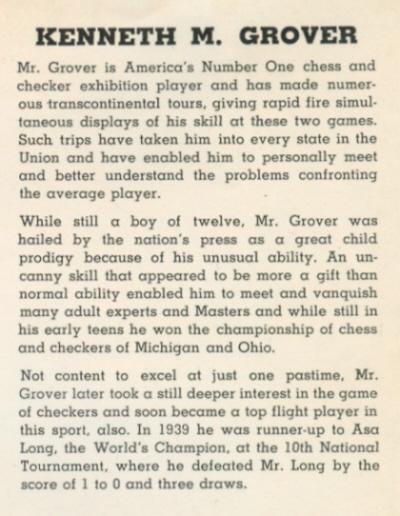
From the dust-jacket of the 1941 edition of Chess by Grover and Wiswell
Regarding titles for over-the-board play, authors and publishers often lose all sense of proportion. The following comes from the back cover of A World Champion’s Guide to Chess by Susan Polgar and Paul Truong (New York, 2005):

There is much more. The front and back covers also describe ‘Grandmaster Susan Polgar’ as ‘Four-time Women’s World Chess Champion’, ‘2004 Olympiad Gold Medalist’, ‘a living legend’ and ‘a four-time Women’s World Champion and the top-ranked woman chess player in the United States’. Once the reader’s toes have uncurled after that torrent, he may feel that it mainly springs from vain indecorum rather than an attempt to deceive, but the same can hardly be said of The Batsford Chess Encyclopedia by Nathan Divinsky (London, 1990), i.e. the book itself and the publisher’s puffery. The following appeared on its dust-jacket:

An alternative view to Batsford’s is provided in A Catastrophic Encyclopedia.
For hype, though, even B.T. Batsford Ltd. of the 1980s and early 1990s has been shown a clean pair of heels by a US publisher. C.N. 2377 referred to ‘the self-glorification in which Cardoza Publishing has recently allowed its chess writers [e.g. Raymond Keene and Eric Schiller] to indulge – dregs pretending to be cream’. The company recently brought out a new edition (supposedly corrected, but not so) of a 2004 book on Fischer by Eric Schiller. The back cover asserts that he (Schiller, not Fischer) is ‘widely considered one of the world’s foremost chess analysts, writers, and teachers’. As shown in our review of World Champion Combinations, those same words were already being used by Cardoza over a decade ago. An alternative view as to what Eric Schiller may be ‘widely considered’ is provided in A Sorry Case and Copying.
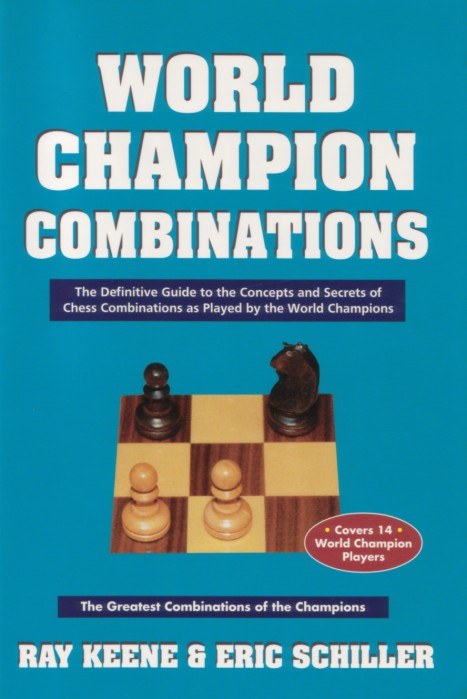
His co-author for World Champion Combinations was Raymond Keene, and opposite the title page was a claim that he is ‘considered one of the strongest players in the world’. The considerers were naturally not named because, as pointed out in our above-mentioned feature article on the book, he played his last serious chess in the mid-1980s, and on the 1986 rating list he was not among the top ten players in England, let alone the world.
Many of his books contain material relevant to the present article, but just one further example will be given for the time being: the dust-jacket of Samurai Chess by Michael Gelb and Raymond Keene (London, 1997) described the latter as ‘the world’s leading authority on chess and mindsports. An International Chess Grandmaster and winner of 14 separate British championship titles ...’
For Tony Miles’ alternative assessment, see his book review in Kingpin.
In descriptions of chess books, has the word ‘definitive’ ever been used legitimately by a publisher, author or reviewer – and to which volumes could it be applied with justification?
(12114)
Addition on 16 May 2021:
The above article originally appeared at ChessBase.com, except that here we have restored a section about Susan Polgar which was deleted from the ChessBase version. Some individuals (such as Raymond Keene, at chessgames.com on 13 July 2009) jumped to the conclusion that we had been ‘censored’ by ChessBase, and there was gossip about legal action having been threatened by Susan Polgar.
Below is an account of what happened, written at the time and confirmed by Mr Frederic Friedel of ChessBase. We envisaged including it as a follow-up to C.N. 6212, but eventually decided not to.
‘Legal threats’ and ‘censorship’ have been evoked on Internet outlets, but here we give the facts.
The article, concerning hype in chess books, was posted on 12 July 2009 and, to repeat our words in C.N. 6212, it ‘gave examples of various kinds, up to and including outright mendacity’. One passage concerned A World Champion’s Guide to Chess by Susan Polgar and Paul Truong (New York, 1995). We ridiculed (e.g. with the term ‘vain indecorum’) the fact that the front and back covers were emblazoned with an exceptionally long string of Mrs Polgar’s titles/achievements.
The following day, some 16 hours after the article was posted, Frederic Friedel of ChessBase received a telephone call from Mrs Polgar, who objected on three grounds: (a) the statements about her in the book were written by the publishers; (b) they were true; (c) our article, with a Pinocchio thumbnail picture on the ChessBase homepage, would be used against her in pending court cases in which her opponents were portraying her as an habitual liar and criminal.
Considering the circumstances exceptional, Mr Friedel decided to remove our article temporarily while consulting us on how to handle the matter.
From our own standpoint, the key considerations were as follows:
i) our criticism, accurate and relevant to the issue of hype, had focussed on the boasting on the covers of Mrs Polgar’s book, as opposed to the issue of veracity;
ii) other cases discussed in the article were obviously far more important, and it was they, and not the case of Mrs Polgar, that had prompted/justified the Pinocchio thumbnail picture;
iii) we were fully prepared to envisage, as Mr Friedel suggested to us, some rewording of the Polgar section;
iv) however, in the interests of speed and simplicity our own preference was to drop the Polgar section.
We therefore proposed deletion to Mr Friedel, who accepted our suggestion. The article re-appeared on-line after a total absence of half an hour or so.
In neither her telephone call nor a confirmatory e-mail message to Mr Friedel did Mrs Polgar express the remotest threat of legal action against anyone. At no point did Mr Friedel suggest to us that the Polgar section of our article should be cut out, and a further disappointment for those hoping for bad blood is that our exchanges with Mr Friedel were unfailingly amicable throughout.
Wanted: examples of chess hype. To begin with, three examples from what should prove to be fertile terrain:
From page viii of the Philadelphia, 1876 tournament book: ‘Harry Davidson, of Philadelphia, probably the most brilliant player in the country.’
Title of an article about John Litvinchuk on pages 15-17 of the March 1980 Chess Life: ‘America’s Most Promising Junior Ever?’.
In 1997 Rick Melton of Arizona brought out two spiral-bound volumes entitled The Complete Book of Chess Tournament Crosstables, covering 1851-1948 and 1949-1967. The ‘Complete’ was accentuated in the title but is complete nonsense. From the period 1851 to 1870 Mr Melton presented seven tournaments, whereas the corresponding figure for the first volume of Jeremy Gaige’s Chess Tournament Crosstables, published in 1969, was 30.
(2201)
The dust-jacket of Chess by K.M. Grover and T. Wiswell stated: ‘Kenneth M. Grover, when 12 years old, was hailed as a chess child-prodigy, and today he is America’s number-one chess player.’ The original (1941) US edition called him ‘America’s Number One chess and checker exhibition player’. In their other books, Let’s Play Checkers (New York, 1940) and Twentieth Century Checkers (Philadelphia, 1946), the twosome also awarded themselves high-pitched write-ups. The back-cover of the former said of Grover: ‘He is America’s No. 1 checker and chess exhibition star and is popularly known as the “Mighty Mite”.’
(2345)
‘One of the greatest masters in the world’ is the description of Fred Reinfeld in the entry for his book Scacchi per ragazzi on page 16 of Lineamenti di una bibliografia italiana degli scacchi by A. Sanvito (Rome, 1997). Our thanks to Alessandro Nizzola (Mantova, Italy) for drawing our attention to this considerable exaggeration.
The English-language edition of Reinfeld’s book, Chess for Children, called him a ‘Leading Chess Master’ and the ‘world-famous chess writer and champion player’. The dust-jacket also declared:
‘Fred Reinfeld is an author extraordinary. Some of his many readers call him a “genius”, and all recognize his versatility and talent. He is probably the most prolific American writer living today, author of about 75 books (more than he can count, he says).’
Yet those affirmations are like the gospel truth compared to the self-glorification in which Cardoza Publishing has recently allowed its chess writers to indulge – dregs pretending to be cream.
(2377)
From page 16 of Twentieth Century Checkers by Grover and Wiswell (Philadelphia, 1946), in a three-page sketch of Grover:
‘The fact that he is without doubt America’s outstanding Checker and Chess exhibition player only demonstrates his amazing versatility.’
C.N. 6212 showed the following:

Chess by K.M. Grover and T. Wiswell (London, 1952)
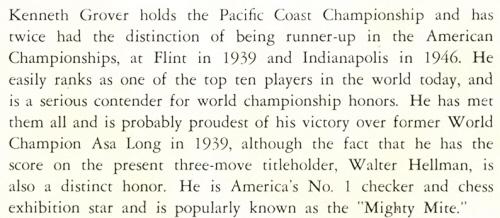
Let’s Play Checkers by K.M. Grover and T. Wiswell (New York, 1940)
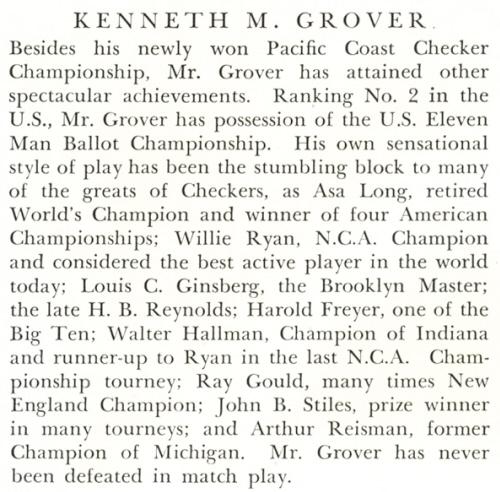
Twentieth Century Checkers by K.M. Grover and T. Wiswell (Philadelphia, 1946)
The frontispiece to Twentieth Century Checkers:
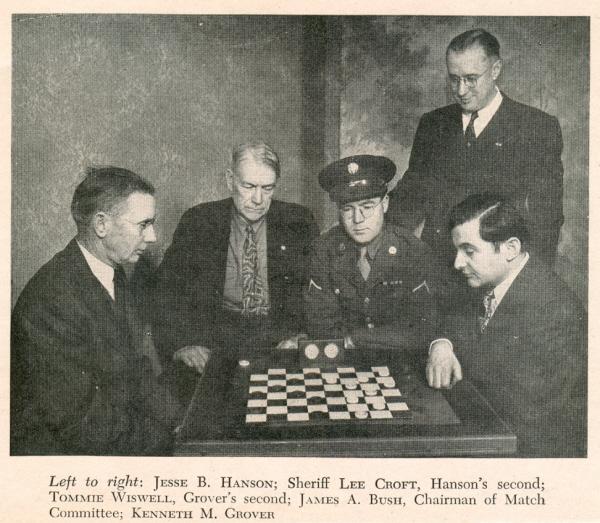
With regard to Grover, see too C.N.s 6222 and 6229.
Which chess book contains the most hype? One promising contender (at least from the pre-Cardoza era) is Fred Reinfeld’s Beginner’s Guide to Winning Chess, which was first published in 1964, the year he died. Here is the back-cover of the 1994/2006 paperback edition from Foulsham (which used the spelling Beginners’):
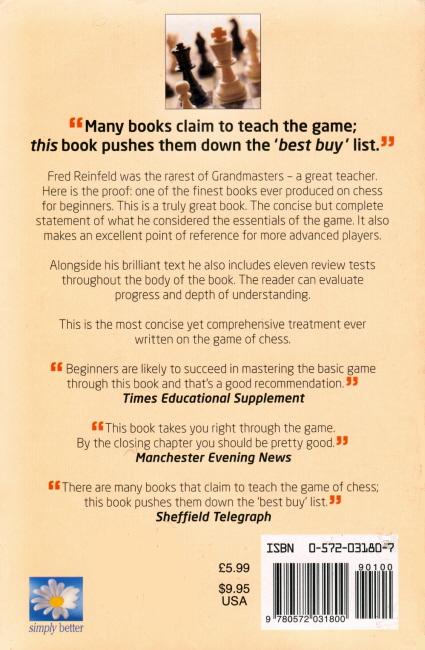
There is plenty more inside concerning ‘the rarest of Grandmasters’. Page 6 (‘About the Author’) starts:
‘Fred Reinfeld was, as Dr M.W. Sullivan states in his introduction to Beginners’ Guide to Winning Chess, a brilliant chess player and “the leading writer on chess in the entire history of the game”. This is indeed saying a great deal, since chess has been played for more than a thousand years, but the overwhelming evidence is that the Sullivan statement is actually true!’
After a page in similar vein, Dr Sullivan takes over the loud-hailer for his introduction (pages 7-8). It begins:
‘Ours is no age for a universal genius, but Fred Reinfeld offers us a close approximation of the ideal. The quality and quantity of his books made him not only the finest chess author of his day, but also the leading writer on chess in the entire history of the game.
Of course, Fred Reinfeld was a brilliant chess player ... as great a writer as he was chess player.’
Much more could be quoted, but we merely observe that it was not one-way traffic. Dr Sullivan was the author of A Programmed Introduction to the Game of Chess, and it included a full-page encomium by Reinfeld which worked itself up to the following finale:
‘... this is the most revolutionary book ever written on chess – a work that is destined to have a profound influence on all worthwhile chess books of the future.’
(6585)
The back cover of a recent work of fiction, Paul Morphy: Confederate Spy by Stan Vaughan (Milwaukee, 2010):
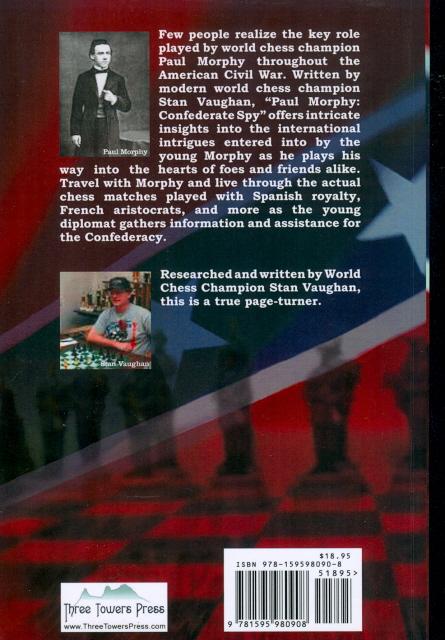
There is more information about the ‘modern world chess champion’ on the final page. It is stated, for instance, that S. Vaughan has the following titles and accomplishments:
(6919)
‘Paul Charles Morphy is the greatest chess player known to history, and it is doubtful if there will ever be a better one. ... What it does seem is that he defeated the game of chess.’
These words were quoted in C.N. 17 from the first paragraph of the article ‘Wizard of Chess’ by Robert Cantwell on pages 1079-1081 of The People’s Almanac #2 by David Wallechinsky and Irving Wallace (New York, 1978). The piece originally appeared on pages 16-18 of Yesterday in Sports edited by John Durant (New York, 1956).
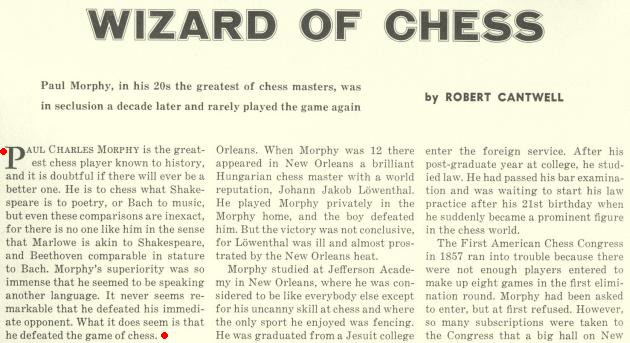
(7239)
As mentioned in C.N. 1853, the dust-jacket of Warriors of the Mind by Raymond Keene and Nathan Divinsky (Brighton, 1989) described it as ‘a seminal work written by two scholars of the game’.
The title page of First Chess Openings by Eric Schiller (New York, 2005) has this description of the book:
‘The best and easiest introduction to openings ever written.’
Fulsome praise has been heaped on the new Blackburne book by Tim Harding by Tim Harding.

Source: Chess Mail (website of Tim Harding).
From C.N. 9592 (see also Reviewing Chess Books):
A reviewer whose own volumes are notorious for blunders and other defects (plagiarism, for instance) should be neither reviewing nor authoring. Nor, of course, should any writer wish to quote favourable opinions received from such a reviewer. T. Harding rushing to cite R. Keene’s fulsome praise of his Blackburne book was a pathetic spectacle.
See too Timothy D. Harding (Chess Writer and Historian).
From pages xviii-xix of Alpha Teach Yourself Chess in 24 Hours by Zsuzsa Polgar, Hoainhan “Paul” Truong and Leslie Alan Horvitz (Indianapolis, 2002/2003):

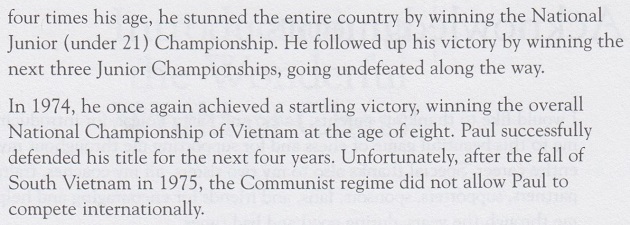
It is true as a matter of public record that South Vietnam fell in 1975.
(11429)
Regarding the Oxford Encyclopedia of Chess Games by David Levy and Kevin O’Connell (Oxford, 1981), W.H. Cozens (Ilminster, England) informed us in a letter dated 21 February 1984:
‘Cafferty recently asked me to review, for the BCM, that Oxford collection “of all the games ever played”. It is the first time he has asked me for a review but in all conscience I had to turn it down. I do like to have something good to say about a book, but in that case I fear the Oxford Chess Dept. has been the victim of some unscrupulous sales talk.’
Addition on 6 February 2022:
Tim Gluckman (London) notes that the back cover of Aleister Crowley: The Biography – Spiritual Revolutionary, Romantic Explorer, Occult Master – and Spy by Tobias Churton (London, 2011) contains a claim that ‘he was one of the greatest chess players’:
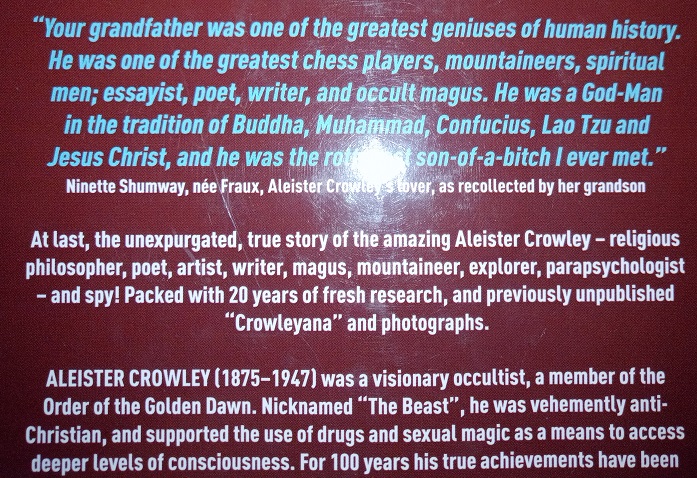
Our correspondent adds that chess is not mentioned in the book itself.
Concerning Alpha Teach Yourself Chess in 24 Hours see too C.N. 3343 in Chess Jottings.
In descriptions of chess books, has the word ‘definitive’ ever been used legitimately by a publisher, author or reviewer – and to which volumes could it be applied with justification?
(12114)
To the Chess Notes main page.
To the Archives for other feature articles.
Copyright: Edward Winter. All rights reserved.